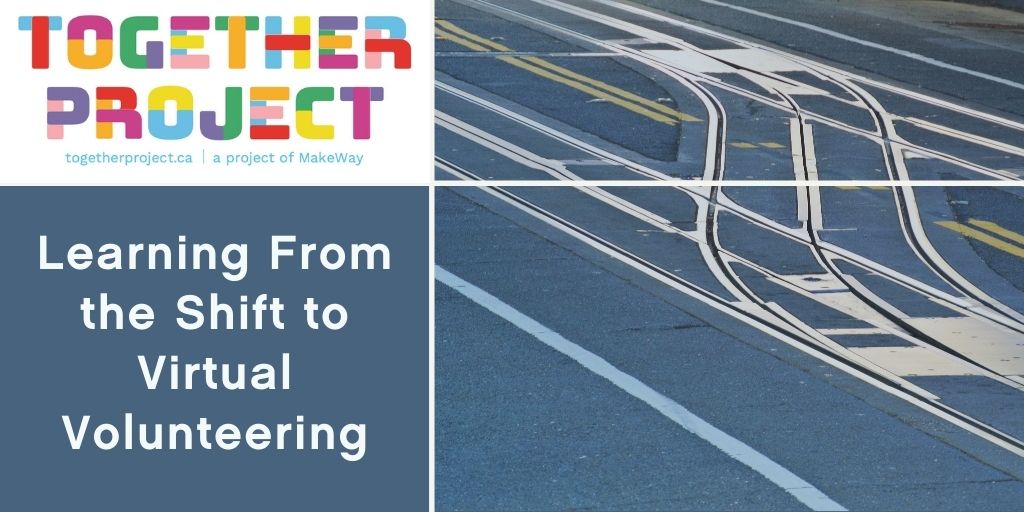
Together Project, a charitable initiative of MakeWay, connects refugee newcomers and Canadians to build stronger, more integrated communities. Based in the Greater Toronto Area, our flagship Welcome Group program matches groups of five or more volunteers with newly arrived refugees for six months of social and integration support.
When the COVID-19 pandemic hit and the lockdown occurred in March, Together Project had about 150 volunteers who were already participating in six-month matches with Government-Assisted Refugees, and we were just launching a new pilot program to match another 150 volunteers with refugee claimants. We realized that we had to transition our Welcome Group Program to a virtual model, and fast – this was a precarious situation for an already vulnerable population. The question was how we could best manage this pivot. Our existing model already incorporated some online tools, but we discovered through a needs assessment process with both volunteers and newcomers that we needed a deeper overhaul of the program for it to really work.
Using the Code as a Road Map
We had already been familiar with the standards of practice outlined in the Canadian Code for Volunteer Involvement (CCVI) as they had provided much needed structure to our existing program design. Given the need for a top-to-bottom approach in our adaptation to the pandemic, we looked at each of the CCVI standards of practice as pivot points for how to map existing programmatic components onto virtual platforms.
Defining volunteer roles and how to recruit for them (standard 5), for example, was a useful starting point for considering what characteristics we needed to seek out in new volunteers, and how we would help them understand the virtual context they would be operating in. This helped us honestly delineate who would – and would not – be a good fit for the program.
Similarly, we looked at how we could modify our orientation and training materials (standard 8) to better fit our focus on remote social support. Shifting our intake and orientation sessions online was fairly straightforward; the challenge lay in modifying (and re-modifying) the content to provide practical examples and stories that would make volunteer tasks and responsibilities more relatable to new participants. We also quickly learned that while a two-hour orientation session can work well in-person, it can be hard to maintain focus on a Zoom call that goes on much longer than an hour – better to shorten the session by refocusing on the essentials.
When it came to risk management (standard 6), as well as support and supervision (standard 9), there was a lot of learning that we had to do internally in order to keep up. What did risk look like in a virtual environment? What did we have to consider about remote social support that we didn’t previously? We took the opportunity to think about how we could use the very tools that we were asking volunteers to familiarize themselves with in their new roles to better supervise and support them. For example, we could use Zoom calls with Welcome Group volunteers to help them troubleshoot issues in their matches or simply to catch up. Emergent volunteer preferences – what video software works best, how to stay connected and organized with your group – could also be introduced into our innovation cycle for inclusion in the next iteration of the program’s implementation.
We also looked at how we could adapt our recognition of volunteers (standard 10) to a virtual environment. We leaned into sharing the stories that were coming out of our matches, featuring them in our interview series and launching a podcast to provide potential new participants and other stakeholders with real examples of what virtual volunteering can look like. Similarly, we wanted to make sure we were internally evaluating (standard 4) vital information around what in our adaptations was especially effective (or not). What we were evaluating was also novel: by treating the entire adaptation process as a pilot project in and of itself, we could apply the principle of evaluation and use the opportunity to learn.
What we’ve learned so far
Since the start of the pandemic, we have trained about 300 volunteers to offer remote social support to newcomer households in Toronto and Mississauga. Both through supervising our volunteers’ activities and in asking them to participate in our evaluation process, we received important feedback about the advantages and limitations of virtual volunteering.
The advantages should come as no surprise when considering adapting almost any service or program to a virtual format. Geography is suddenly near-meaningless as a key criteria for our program. Scheduling becomes much more flexible, be it for volunteers “meeting” with the newcomers in their match, or for our staff organizing orientation sessions. Our new focus on online tools, like cloud software and video conferencing, has led to a lot of emergent learning around what keeps volunteers better organized and therefore more effective.
There are also significant limitations to shifting to an almost entirely virtual program. For a program designed around the importance of building social connections, the most glaring challenge is often technological and should come as no surprise to those of you who have been using video calls for work or to communicate with friends: it’s a lot harder to feel connected to someone over a screen, and this is doubly true when you’re meeting that person for the first time (and triply if there is a language barrier).
If there is a silver lining to the pandemic, it is that everything that we’ve learned to date about adapting our volunteer program to a virtual environment has been hugely instructive not only in continue to plan for delivering our program on the shifting sands of the pandemic lockdown, but also in helping us consider which of these tools and adaptations should be permanently incorporated into our work in a way that makes for more effective program delivery, and ultimately greater impact.
Andrew Lusztyk and Anna Hill, Co-Directors of Together Project
